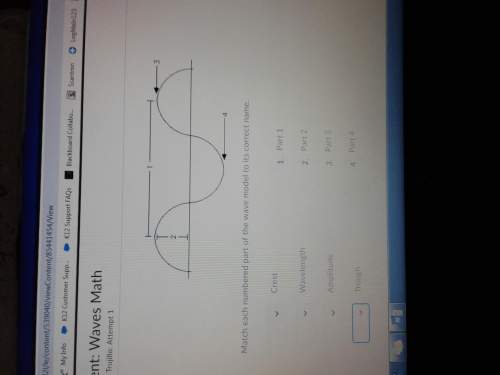
Physics, 14.07.2019 00:10 tzartiger12
This is the famous brachistochrone variational problem of determining the path o quickest descent along a frictionless slide, under the influence of a constart gravitational acceleration, g. assume a two dimensional motion, where x is the horizontal spatial coordinate (perpendicular to the gravitational field). and y is the spatial coordinate which increases down (in the direction of the gravitational acceleration vector, g). where the path to be determined is y(x), which extends from the origin (0,0). to the destination point (xo yo). a) write down the time functional. t t-jd - jdsf where y(x) is the path of the brachistochrone, for the minimum time of transport, which is to be determined from the variational calculation. the integrand, f(x. y,,x). can be determined by expressing the time differential as a ratio of the spatial path differential, ds, divided by the velocity, v, along the path, or di -s. note that, in general, the spatial path differential can be expressed in terms of the two- dimensional, x -y. differentials, as ds-dy. also, note that the velocity v, along the path, can be determined by energy conservation (kinetic plus potential energy). e= ke+ pe, where the initial gravitational potential energy, pe-my , is continually converted into kinetic energy, ke-/2, as the object moves in the downward vertical direction, or positive y direction. since the velocity can be expressed in terms of y, and the spatial differential, ds. can be expressed in terms or a function of the derivative of the path, φ(x) /dr=y,, times the x differential, dr, the time differential, di. can be expressed in the form given above, dà-d r(y, y,,x). specifically, write down this time functional, t. as an integral over the r coordinate, from o to also, write down the specifie integrand, f(у, y,,x). b) note that the extrem um or the time functional can be determined by the zero of the time variation, st-0, which is solved by -0. and for the case that the integrand, f. does the euler equation, rata not explicitly depend on x, where f=f(xy'). then the variational problem is solved by the alternative form of the euler equation, or f-y,-= k, where k is a constant. given this simplified approach to the solution of the variational problem for the minimum time of descent, you should be able to use the integrand, f(у, that you found in a). above. in this alternative euler equation to rewrite the equation to be solved as y where c isa constant that is related to the k constant. e) this equation can be solved by by, isin"(ф/2), where dy/dr can be expressed the variable substitution y(9) in terms of doide. you should be able to transform this differential equation, in y and x. into a differential equation in ф and x. ultimately the differential equation can be solved by integration, where the integral over x, on one side of the equation can be performed. and the integral over φ, on the other side of the equation can be performed. given the boundary condition that at x=0, then φ = o. since y : 0, the specific solution for x(é). can be found. the point is that you will have the solution of x and y. which is a cycloid, expressed in parameterization with an angle variable, φ, write down the explicit final brachistochrone path, x() and where the path domain is os#5π.0 s s π /2c2,0sys1/c", so that the end point (x.π/2c2,1/c"). sketch the path. d) calculate the time of flight along r_ld fejd.| the brachistochrone path. t.-d]. expressed using the given parameters, g, c. the point is that you should be able to transform the integral of the time along x , into an integral along ф. using the calculation that you went through in c), above, where the integral will be easy to solve. e) also, calculate the time of flight along the straight line path, y(x) 2x. note that this can be calculated with this straight line function, using the original time functional, t-jdyf. again, this integral is not too bad, and can be done expressed in the given parameters, g, c、 f) finally, show that the ratio of the straight line path time to the minimum time for the brachistochrone, is expressed 는(l+흙)'.1.2, which ls fairly significant, sincethe straight line path is the shortest distance between the two points; however, the brachistochrone path turns out to be optimal, giving a 20% decrease in time! describe physically why the brachistochrone path might exhibit a shorter slide time than the straight line path.

Answers: 1


Another question on Physics

Physics, 22.06.2019 07:00
We put a force of 50n on an object and the acceleration is 100 m/s². what is the mass of the object?
Answers: 1

Physics, 22.06.2019 18:10
Aa a of 22 m/s at an of 36.9 .be . a. b. c. (3)x y of? (3)go? (4) () it to to ?
Answers: 1

Physics, 22.06.2019 18:30
Asmall 12.00g plastic ball is suspended by a string in a uniform, horizontal electric field with a magnitude of 10^3 n/c. if the ball is in equilibrium when the string makes a 30 ° angle with the vertical, what is the net charge on the ball?
Answers: 1

Physics, 23.06.2019 02:00
Farmer a has a deep well and needs a lot of water for her animals and crops. her neighbor, farmer b, has a shallower well. he needs less water than farmer a because his farm is smaller. in years of drought, sometimes farmer b can't get any water from his wells. what can farmer b do to decrease the likelihood of his well running dry?
Answers: 3
You know the right answer?
This is the famous brachistochrone variational problem of determining the path o quickest descent al...
Questions

Biology, 11.11.2019 08:31



Mathematics, 11.11.2019 08:31




Mathematics, 11.11.2019 08:31



English, 11.11.2019 08:31

Social Studies, 11.11.2019 08:31


Mathematics, 11.11.2019 08:31

Mathematics, 11.11.2019 08:31


Biology, 11.11.2019 08:31


History, 11.11.2019 08:31





